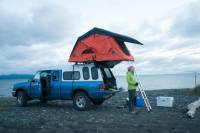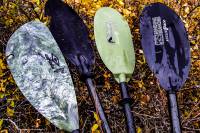Products You May Like
This is the gear you need to start kayaking.
People begin kayaking for different reasons — for physical fitness, for mental health, to fish, or to join a friend who has a kayak. And some people enjoy access to a sport where leg strength or mobility is not required.
We’re here to help you navigate the exciting world of kayaking for beginners. In this article, we focus on kayaking in still water — primarily in lakes.
This guide focuses on items to bring kayaking and will not dive deep into water safety, which is crucial to the experience. We recommend you educate yourself further before the first launch, whether from a guide, a friend, or another online resource.
The Essential Kayaking Checklist for Beginners
Kayak
A sit-on-top kayak is the best choice for a true beginner. In general, they are more affordable, more balanced, and sturdy on the water. They’re also easier to climb back onto after a fall into the water.
However, they can be heavier, bulkier, and slower. Fishing kayaks are commonly sit-on-top style.
A sit-inside kayak for still water and ocean kayaking is often referred to as a “touring” kayak, but it also comes in shorter lengths, known as a “recreational” kayak. These boats have the option of using a spray skirt.
A touring kayak is typically longer (improving stability and glide), thinner in width (hugging closer to the body), and made of lightweight materials. These kayaks are more challenging to get in and out of, even on shore. If you tip over while out on the water, getting back inside is an acrobatic art form.
There are also inflatable kayaks, nesting kayaks, and folding kayaks (that you can wear like a backpack). If your No. 1 priority is easy transportation or the ability to hike into a launch point, be sure to check out one of those newer designs.
There are tandem kayaks that provide two seats in one boat for two-person excursions. They come in both sit-on-top and sit-inside models. There are even inflatable tandem kayaks.
Choosing a Kayak
No matter the style, your kayak should fit your body shape, size, and weight. If possible, test out the kayak before purchasing, or test out a comparable kayak (the same style, length, weight, etc.).
Most outfitters that rent or do guided kayak tours allow customers to “test drive” kayaks. Many of them will also sell used boats. If this kayak is for solo use, the goal is to feel that your kayak was made for you, that you feel one with the boat.
The most important consideration is whether you’ll be kayaking solo, or if there will always be someone around to assist in transporting the vessel to the water. Before purchasing a kayak, plan for how to get the boat from point A to point B, and for you to get inside the kayak and paddle out on the water.
Vehicle Rack/Transportation
Unless storing your boat on the shore of a body of water, transporting the kayak from your home to a lake or ocean is paramount. As is the case with skiing and cycling, this typically necessitates a vehicle rack.
Do you have crossbars on your vehicle already? That will be the first necessary item. Next, choose the type of carrier. This depends on vehicle type, whether or not the adventure is solo, and, of course, your budget.
To be able to kayak on my own at any time, I’m a fan of the hand-roll system (e.g., Yakima HandRoll Kayak Rack Mounts). I have a 4WD truck with a camper shell and crossbars, where I can barely reach the roof.
These rollers allow me to lean my kayak against the truck, pick up the back end, and push the whole vessel along the rollers. These are on the back, and I opt for the Yakima DeckHand Kayak Rack Mount on the front both for stability and because the kayak easily slides across these as well.
The majority of popular rack mounts are some form of the J-bar (e.g., the Yakima JayHook). These have the benefit of fitting several watersports vessels — surfboards, canoes, and SUPs (standup paddleboards) — in addition to kayaks.
However, I don’t recommend them when loading and unloading a kayak solo, especially if the roof of the vehicle is exceptionally high or the boat is especially heavy.
The most affordable option is kayak foam blocks. If you want to get scrappy and worry less about scratches on your vehicle, simply buy pool noodles, cut them to size, and use zip-ties or duct tape to keep it attached to the vehicle’s crossbars.
Ropes & Ratchet Straps
To keep the kayak attached to the rack of your choice, use tie-down ratchet straps. Most racks come with straps, but they’re usually not as high-quality and secure as the good ol’ ratchet strap.
Lastly, if you can’t carry the kayak from the vehicle to the water, use a kayak cart. Pay attention to the weight capacity and the type of tires to choose the right cart for your vessel.
Paddle
A kayak paddle is one long stem, with a paddle on each end. They’re made from different materials, most are collapsible into two pieces, and some are specific fishing paddles. Paddles also come in various lengths and should be chosen based on your height.
The three main material options for the shaft are aluminum, fiberglass, or carbon fiber (in order from heaviest to lightest). The blades will also be a different material, typically dependent on the shaft material (plastic, fiberglass, nylon, etc.).
For beginner kayakers who will be out for fun, whatever is most affordable is fine. For long trips or physical fitness when moving at a fast clip, I recommend the carbon fiber with hand grips.
A paddle can be matched or feathered. Matched means that the blades lay at the same angle to one another and the water. Feathered means the blades are at slightly different angles to one another and the water. Most paddles allow kayakers to choose the type of paddling as well as the angle depending on what feels most comfortable.
Other features — like the shaft design and the blade size, shape, and angle — are less concerning in kayaking for beginners. You can also opt for a paddle that breaks down into four pieces for easier storage if you choose to get an inflatable, nesting, or backpack kayak.
Kayak Safety Gear
PFD/Life Vest
All bodies of water require each person to have a personal flotation device (PFD/life vest) per person on a boat. Usually, you’re not required to wear the vest while paddling. However, my recommendation for beginner kayakers is to wear your PFD at all times, especially when getting to know your boat or while on an unfamiliar body of water.
Fortunately, the PFDs of today are much more comfortable and fun than those of yesteryear. There are even kayaking-specific PFDs that allow for more range of motion around the arms, and women’s-specific PFDs that allow for more space in the chest area.
Bilge Pump
If you have a sit-inside kayak, get a bilge pump. If you get significant amounts of water inside your vessel or it flips over, this is a necessary safety tool. Likely (and hopefully), you won’t use it often, but always keep it close, especially during long or overnight tours.
Also, a bilge pump can be used when drying and cleaning out the kayak on shore before storing it for the next trip. NRS offers a Touring Safety Kit, which includes a bilge pump and a few more items listed below.
Sponge
A boat sponge will help remove small amounts of water from the boat, as well as pieces of grit, sand, and dirt the bilge pump can’t reach. Keep the boat clean and dry between launches. This is especially important if launching in different bodies of water, if these waters are in national parks, or your boat is undergoing a mussel inspection.
A sponge can also be used during your paddle to keep your feet or bum from getting soaked if you do have small amounts of water inside your boat.
Whistle
Another item that you should always have with you, but hopefully not need, is a whistle. A whistle can be used to call for help in case of an emergency. Sounds on the water often either echo out on the water or are muffled, and it may be surprisingly hard to see someone who seems close in proximity.
If you tipped over, have an injury, or any other emergency, a whistle may get you the help you need, as your voice may not carry as far.
Paddle Leash
While kayaking, pause to enjoy the scenery around you. Maybe relish a sip of coffee or lazily hold onto your fishing rod and line. To prevent paddles from floating away while you revel in nature’s beauty, use a paddle leash. This is also a huge help when getting in and out of your kayak, especially for kayaks with a cockpit.
Water Bottle/Bladder
Like any other outdoor activity, you must have water with you. On a kayak, it can get lost in the large body of water you float on. Ensure that your drinking water is both easily accessible and attached to your body or something on the boat.
For a kayak, I would recommend a water container that is a flexible pouch, rather than hard, so that it can lay flat and not roll around. The HydraPak Stow is a secure and sturdy pouch that comes in different volumes, with a loop that attaches to a carabiner to then attached to your boat or your PFD.
Sunglasses & Hat
We all have our favorite types and brands of these go-to sun protection items. While kayaking, keep the wind and the possibility of falling in the water at the front of your mind.
In case you fall in the water, be sure to attach a strap to your sunglasses or get floating sunglasses. Croakies and Chums are the go-to brands for sunglasses straps that also float.
I find the straps with flotation to be bulky and uncomfortable. And the original version, if fastened securely to my head, keeps my prescription sunglasses on, even when I jump off a rock along the shore.
If you have long hair, especially curly, be careful when securing. Hair gets snagged, but it’s worth it if you care about your shades.
The Bomber Brand sunglasses have a variety of stylish designs that all use patented floating technology and are popular among boaters. There are other brands out there, but I’ve personally seen these in action, and they indeed stay afloat.
Keep your hat attached in high wind. Get a hat with a drawstring and a 360-degree brim, like this quick-drying and lightweight Patagonia Baggies Brimmer Hat. Or get a stretchy hat that can secure snugly to your head more than a standard trucker hat, like these Outdoor Research sun hats or Patagonia’s Duckbill Trucker Hat.
Pro tip: If you have long hair, put your ponytail or bun through the hole of your cap so that if it does blow off, your hair will catch it!
Water-Friendly Items
Waterproof Case for Phone
The LifeProof FRE Series is available to both iPhone and Samsung users. Make sure to choose the right brand and model of phone for the case.
I live in the snow for half the year, and the other half I kayak on lakes or backpack. My phone hasn’t taken a full dive into a body of water yet, but it’s been splashed and covered in snow and has yet to be affected. Also, LifeProof has a fantastic warranty.
If you already have a case and want to save money, get a waterproof pouch or a hard case. Or place your phone with other items in a dry bag.
Dry Bag
A quality dry bag is super useful on the water. I’ve used the same Osprey 6L Dry Bag for about 5 years now on every adventure, and nothing inside has ever gotten wet.
It’s lightweight, compressible, and even a little stretchy. This allows you to put a few items in for a day paddle or to pack it tight full of clothes for an overnight.
Water Shoes/Sandals
Unless you’re paddling during cold, winter-like weather, the best footwear is something made to get wet. I don’t recommend going barefoot because it will make walking onto most shores challenging and unsafe. Instead, wear the same comfortable shoe from your vehicle to the launch point and back.
My personal favorites are the KEEN Venice Sandals or the KEEN Newport H2 Sandals. (We linked the women’s models here, but they also come in men’s and kids’ sizes).
They are comfortable enough to hike in and are still lightweight. They also have a protected toebox, which is an essential feature for someone who may launch from rocky shores.
Swimsuit
Beginner kayakers are fair-weather paddlers, so swimsuits are often the best clothes for the job. Wear the most comfortable one you have, one that dries quickly drying, keeps everything in place, and allows for the best range of motion in your arms.
I often wear my swimsuit with a long-sleeve hiking shirt, like the Helly Hansen Active Crew or a lightweight, wicking button-up, to cover my shoulders and make it more comfortable to wear my PFD.
Rain Jacket
When kayaking, precipitation and splashes are always present. A waterproof or water-resistant jacket is a piece of gear that can make your paddle far more enjoyable by keeping you dry.
My Marmot Minimalist Jacket has kept me dry while kayaking through a storm on the ocean in New Zealand and allowed me to enjoy my paddle during a cold, windy day on Lake Tahoe. A rain jacket is also an excellent windbreaker.
Be sure you purchase one with zippers under the armpits so that you can stay dry and warm but also well-ventilated.
Other Kayaking Gear
Camp Chair
Some of my favorite kayak memories are when I pack a lunch and my backpacking chair and paddle across a lake. The REI Co-Op Flexlite Camp Chair folds down to the size of a small loaf of bread. If you have a storage compartment, it will easily fit inside.
Towel
Of course, you can use a regular towel, but a quick-dry towel can be stowed on your boat or vehicle in a dry bag, ready for the next adventure without creating that musty smell. A regular tower can also be used in drying off your kayak.
Dry Change of Clothes
If you get significantly wet and want to enjoy a cozy ride home, I suggest having dry, warm clothes to change into, waiting in your vehicle. Pack a hoodie, sweatpants, and maybe warm socks and Crocs.
Or if it’s a stifling-hot summer day, wrap up in your towel and hit the road.
Phone App for Bodies of Water, Launch Points
When I first began kayaking, and while I was on a road trip, using an app was instrumental. It helped me find nearby still water and the best launch points (especially the free ones). But if you plan to paddle in just one or two local bodies of water, this is not necessary.
Go Paddling is simple and will help you find the best places to paddle nearby. It includes details on the amenities offered at the launch point and whether it’s free or paid. It’s available for both iPhone and Android.
Phone App for Weather
Never head to your launch point before checking the weather. Like most outdoor adventurers, this is a frequent topic of conversation.
For paddling, your main focus is the wind. In kayaking for beginners, go out only during warm weather where you would feel comfortable falling in the water and would enjoy it.
The Wunderground phone app allows you to choose specific weather stations nearest to your launch point and provides hour-to-hour wind changes. It also has the option to view a map, with radar, if you’re choosing between a few nearby options.
Lastly, if you are going for the typically calmer periods of sunrise and sunset, that usually sees fewer people and less wind, these times, for each specific day, are included on the app.
Kayaking for Beginners
Don’t let our essential checklist or the details here overwhelm you. We’re providing comprehensive information for your safety and ease.
After a few trips, and after getting to know your boat and your local body of water, you may take your kayak out with only your paddle and PFD, knowing it will be a short, safe, relaxing trip. Or, you might want to step up your game and learn more about overnight kayaking.
Even better, maybe you want to share your kayak knowledge and your vessel with a friend, and teach them the ropes of kayaking for beginners. Either way, we hope you find this guide useful and are excited to navigate this new adventure with you!






